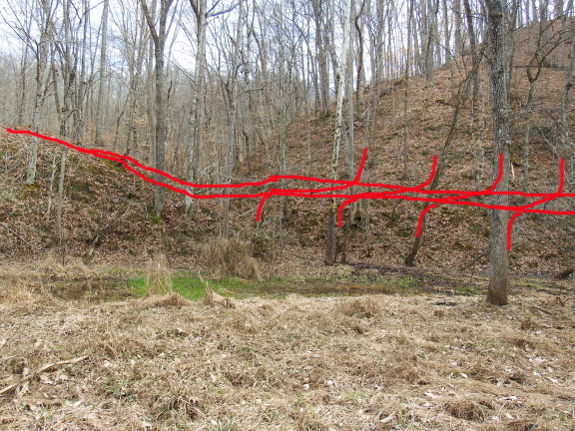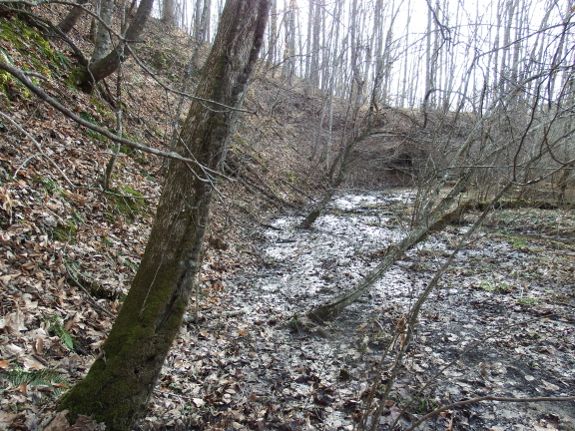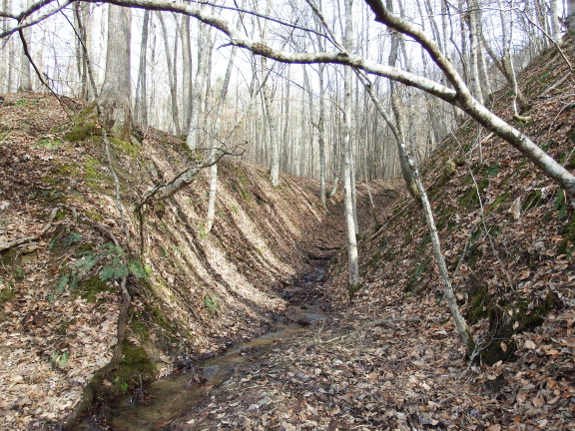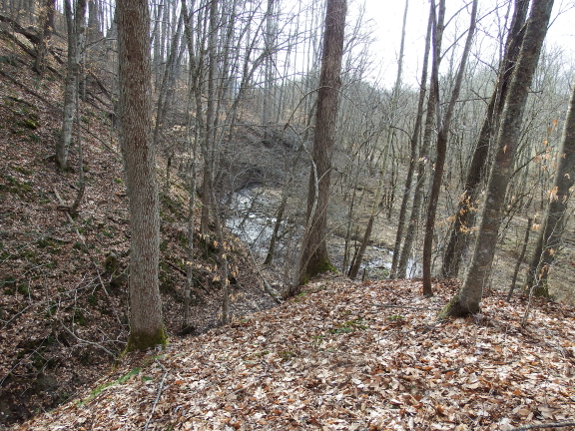
Imaginary driveway

It's decision time around
here. Do we take the money we've been saving to improve our access and
sink 100 tons of rip rap into the 680 feet of terribly marshy floodplain our driveway currently traverses?
(That sounds like a lot, but I suspect it would be a mere drop in the
bucket.) Or do we use the cash to hire a neighbor with a bulldozer to
try to carve a path out above the floodplain, a task that might come to
naught if he hits bedrock too soon, and one that would require building a
bridge across a rather large gully?

Here's a bit more
information about plan B. After crossing the creek, there's easy access
up onto the knoll you see at the right side of this photo, but the
hillside the bulldozer would be carving into is difficult, to say the
least. There would be a lot of short-term devastation involved (although
perhaps not more than we cause on an annual basis tearing up the wet
soils of the floodplain). And our neighbor warned us that there's no
guarantee he won't hit rock before he's able to carve out enough earth
to make us a road, which would mean we had sunk our money into a project
with no improvement to our access at all.

Then you reach a gully,
which our bulldozing neighbor says would have to be bridged --- he's
pretty sure his equipment won't continue carving around the bank you see
on the right as it runs up this little cove. Instead, he recommended
felling two trees to make a bridge for our ATV (which is the intended
recipient of whichever driveway fix we decide on). Mark and I don't like
the idea of a bridge rotting out under us after a few years, though, so
we might instead see if we could find a big culvert or two to bridge
this gap (and find out whether the bulldozer can haul them in). Unlike
our main creek, this little rivulet dries up in the summer and never
gets big enough to wash a culvert out, so a bridge here is more feasible
than in other locations. (Our most recent flood reached about six
vertical feet up the side of the hill here, but it should stay clear of
the top of the bridge.)

If we were able to carve around the bank and bridge the draw, we'd be home free. Up here is where Joey's yurt
stood, and an old logging road runs between this spot and our core
homestead. All it would take is a little chainsaw work to make the route
passable with the ATV and it's all dry, with no creeks to ford or swamp
to traverse.
It's hard to decide
between plan A and plan B because we don't have any solid cost estimates
for our neighbor's work, for culverts, and for the eventual rock that
would need to go down to hold this driveway possibility into place. Our
neighbor says it would probably take about two days of dozer work,
assuming all goes as planned, but when does anything ever go as planned?
While Mark and I are
mulling it over, I'd be curious to hear your thoughts. Assuming all you
wanted was to be able to haul in manure and straw a few times a year,
would you go for plan A or for plan B? If you were looking for a big
culvert, where would you look and how much would you expect to pay?
Want more in-depth information? Browse through our books.
Or explore more posts by date or by subject.
About us: Anna Hess and Mark Hamilton spent over a decade living self-sufficiently in the mountains of Virginia before moving north to start over from scratch in the foothills of Ohio. They've experimented with permaculture, no-till gardening, trailersteading, home-based microbusinesses and much more, writing about their adventures in both blogs and books.
Want to be notified when new comments are posted on this page? Click on the RSS button after you add a comment to subscribe to the comment feed, or simply check the box beside "email replies to me" while writing your comment.

Personally, I think the high ground is the best investment for the future. Water is relentless.
Having said that, I would first find a way to assess the bedrock along the planned high ground route. There are companies that do this, but there might also be diy ways of accomplishing the same thing. When you know exactly what you would be dealing with, then you can make a more informed decision.
Good luck!
About a year after we bought our Shenandoah Mountain property, we decided we needed to improve and move a road to where we intend to build our forever home. The knoll was about 2,000 feet higher than than the lowest spot on our property and would require about 800 feet of new road to be built along the shallowest slope of a very steep hill.
We were blessed with having a steel bridge already in place to ford the stream at the entrance to the land, so getting an earth-moving machine where it needed to be wasn't as much an issue for us as it would be for you, but we did learn a few things that may be relevant to your decision:
While Hubby and I carefully laid out the path we wanted the new driveway to be, following the slope at a gentle incline, the man and bulldozer had different ideas once he got started. He took the driveway up slightly higher grades and put in the bend not where we indicated. While we were annoyed at the divergence from the plan, we had to finally trust that he knew better about the capabilities of his machine and where the road would be better laid. Our terrain is identical to yours and bedrock was an issue. He adjusted the road to deal with the jutting rock and crumbling soil on the fly. Perhaps your excavator will also be as confident and problem-solving.
Charlie (our contractor) charged us about $2,200 for what ended up being only a few hours work. Once the big machines move in, they make quick work of what would be months of hand labor. We found it to be a good value for what we got. He was an independent operator and grateful for the extra work. A lot of country folks are. I believe we paid a fair price and helped a neighbor at the same time.
Earth moving and tree-felling with a big machine is not for the faint of heart. It did look like complete devestation for the first year afterwards - broken trees, bare exposed roots, bare rocky soil - but after a year, the landscape has mellowed and Mother Nature is reclaiming her own. We have harvested much of the downed wood to use in our Hugel beds, and it has created a lot more edge space - the younger trees and mountain laurel are sucking up the new light coming through the canopy with abandon. We have also used the margins along the new driveway to plant flowering trees to soften the harshness of the gash.
While our new driveway is now (approximately) where we originally envisioned it, if I had to do it all over again, I would ask that Charlie make it wider than the width of his bulldozer blade. Our small Subaru can manage the narrow track, but when we start building the house, I doubt the Big Machines will be able to do so. I would recommend that you over engineer your road now, rather than have to do so again later in case you ever need a vehicle larger than an ATV to traverse your property.
I'm not sure our experience is giving more weight to either of your options, but anytime we can share our experience with folks who are pondering similar situations, we all benefit.
Have a great day, y'all.
To check for bedrock: Drive a length of rebar every 10-20 feet along the proposed route on the uphill side. Chart how deep it goes before stopping at each point. Calculate if it will level out with a 12 foot wide road. Find where an old culvert has been removed and the hwy dept will give it for free. Start with truck able bridge across main creek. I had two 30 ft bridge timbers in the barn at my old farm. Bet they're still there. Re check possibility of entering from up creek side of property--cost of buying right-of-way.
Check for bedrock with rebar or a posthole digger. Then make the road big enough for your truck.
I've been reading this blog for seven years, hearing about your creek and mud track issues. The only downside I can see is a future lack of posts about being stuck on the homestead because of a flood LOL. Plus, you are not getting any younger, and things get more difficult as you age. Dry, year round access might even save your life someday.
Plan C. Here in Japan, farms sometimes build a monorail to their mountainside terraces, or even to isolated hamlets that have no road access. A lawnmower sized engine pulls a driver's seat and a flatbed car with 4-500lbs of stuff up slopes up to 45 degrees. Very low impact, sturdy, but slow (40m/min).
This is probably expensive and/or time-consuming, but I think stone bridges are very cool. Could you build (or have someone build) one?
Based entirely on my freshmen level psychoanalysis skills, I think you should pick plan B because I think that is the one you are currently most hopeful for.
That or a small hubbercraft?
How much trouble you'll be having building a road in the marsh depends on how deep it is. The thing with trying to build on marshy soil is that you have to connect whatever you're building to a solid layer below, otherwise it'll just sink. This is the reason that e.g. in Amsterdam houses are built on piles driven into the marshy ground until they reach the underlaying hard sand layers. If you put a layer of riprap on top of your marsh, it will just sink over time. You'll have to keep adding riprap until your layer of riprap is thick enough to fill the whole swamp. And then you might still have issues with high water.
W.r.t plan B, others have already mentioned how you can probe for rocks. A well-constructed wooden bridge will not rot away in a couple of years, provided it it high enough above the water to stay dray, and the abutment is well-constructed. The problem with bridges is generally building the abutments. It must be sturdy enough not to move or wash away. And when using a wooden bridge, it must keep the ends of the beams dry.
For a relatively small span like this, a beam bridge would suffice. The question is how much load does it need to carry, and how much deflection (bending) will you accept under maximum load? I can guarantee you that a bridge that is just strong enough will deflect way more under load than you'll be comfortable with.
If you'd build a beam bridge with e.g. abutments built from cinderblocks and cement, the weight of the components that need to be transported will be limited. And if you don't want to haul around long beams, you could even go for laminated beams built on-site out of relatively short and light planks.
http://www.motherearthnews.com/diy/how-to-build-a-log-bridge-zmaz84mjzloeck.aspx
Says a tree beam bridge lasts 20 years
I still think you should consider a ferry raft.
the raft http://www.bradleyit.com/1/post/2013/05/new-post.html
In use as a ferry https://www.colourbox.com/image/ferry-raft-floats-on-the-water-image-11502686.
A lot easier to set up and doesn't fight nature.
I like plan B. The flood plain will swallow everything you put on it over time. We're working on our own access road right now. It's amazing what even a smaller dozer can do. : )
I agree with the other sentiments about the road vs. the riprap. Are there any other options for the dozer route? i.e., if you get some rebar to test for the bedrock depth, could you potentially plot out a route that you know will work with the dozer, even if the one you described above doesn't pan out?
Also, I've seen culverts from time to time on craigslist, but I've never looked at the prices.
Hey, if the place had a nice driveway, it would have cost twice as much to buy and you would be over run with salespeople right?
I do want to ask, since it had an abandoned house and a tobacco barn when you bought it, obviously there was access for those residents. Did they have a road coming in, or cross the creek as you do? Or was there access from another direction, crossing other property that was divided off or sold, with no deeded access to your property?
Jake --- Unfortunately, no other options for the route. Which, I guess, makes testing for bedrock a bit less imperative --- either the dozer can do it, or it can't.
Eric --- I'd say the land would cost considerably more than twice what it cost if the driveway issue hadn't been part and parcel of the land. As for the previous residents, no one had lived here in at least 50 years when we moved in, and I got the impression that back then they traveled on foot and by horse. The path we follow was their original path, as best I can tell from the topo map, although there are some other possibilities that we don't have rights-of-way to. I think our current driveway would be much more feasible if you were just using a horse there every few weeks rather than trying to run a motor vehicle across it. Although, to be fair, we've had dry years where our driveway was pretty passable as-is. Our climate just seems to be running wetter and wetter lately, making that much less feasible.
Anna said: Jake --- Unfortunately, no other options for the route. Which, I guess, makes testing for bedrock a bit less imperative --- either the dozer can do it, or it can't.
Actually I think if there is only the one route that means that it is more important for you to test for bedrock. It would be painful if you had the neighbor come and start cutting a road when it could not be finished. That way you would be out of money and have a scar on the landscape.
Plan B sounds good in the long term for some reasons but there are too many unknowns for my comfort level and will probably end up costing more than you plan.
If you have access to equipment that could dig ditches along your existing drive that would allow the water to drain away. Adding that dirt to the drive so it can be crowned would keep the road from holding water on the surface. I would recommend either making it wide enough that a dump truck could get in to dump gravel over geofabric or at least make it so the ditches are far enough apart that this could be done in the future if your needs change. This could be done in phases as money becomes available and wouldn't cause any unnecessary damage to steep hillsides that could erode.
If you have any access to used telephones from your local utility a couple of those can hold a lot of weight and probably span your creek.
I think a trail to get out on foot in all weather is important to have.
I'm interested to hear what direction you decide to take.
A good guide for wetland road building here. http://www.na.fs.fed.us/spfo/pubs/stewardship/accessroads/recommendations.htm I would definitely try to find the depth of the swamp along your road.